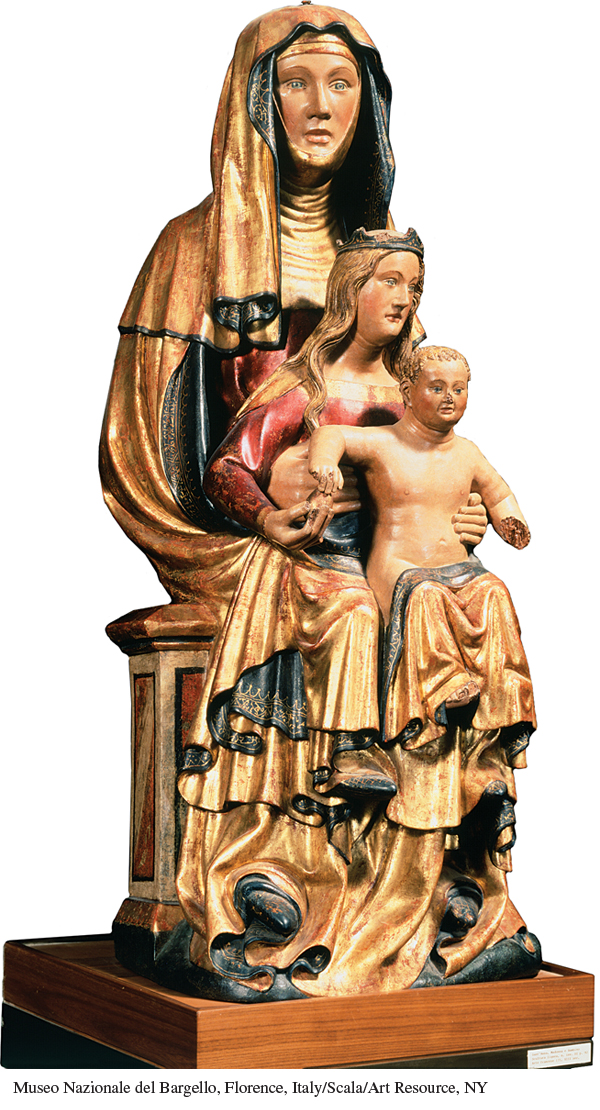A History of Western Society: Printed Page 294
A History of Western Society, Value Edition: Printed Page 280
A History of Western Society, Concise Edition: Printed Page 292
Chapter Chronology
Saints and Sacraments

Statue of Saint Anne, the Virgin Mary, and the Christ Child Nearly every church had at least one image of the Virgin Mary, the most important figure of Christian devotion in medieval Europe. In this thirteenth-century wooden sculpture, she is shown holding the infant Jesus, and is herself sitting on the lap of her mother, Anne. Statues such as this reinforced people’s sense that the heavenly family was much like theirs, with grandparents who sometimes played important roles.
(Museo Nazionale del Bargello, Florence, Italy/Scala/Art Resource, NY)
Along with days marking events in the life of Jesus, the Christian calendar was filled with saints’ days. Veneration of the saints had been an important tool of Christian conversion since late antiquity (see Chapter 7), and the cult of the saints was a central feature of popular culture in the Middle Ages. People believed that the saints possessed supernatural powers that enabled them to perform miracles, and the saint became the special property of the locality in which his or her relics rested. In return for the saint’s healing and support, peasants offered the saint prayers, loyalty, and gifts.
In the later Middle Ages popular hagiographies (ha-gee-AH-gruh-fees) — biographies of saints based on myths, legends, and popular stories — attributed specialized functions to the saints. Saint Elmo (ca. 300), who supposedly had preached unharmed during a thunder and lightning storm, became the patron of sailors. Saint Agatha (third century), whose breasts were torn with shears because she rejected the attentions of a powerful suitor, became the patron of wet nurses, women with breast difficulties, and bell-ringers (because of the resemblance of breasts to bells). Every occupation had a patron saint, as did cities and even realms.
How were saints chosen? Since the early days of Christianity, individuals whose exemplary virtue was proved by miracles had been venerated by laypeople. Church officials in Rome insisted that they had the exclusive right to determine sainthood, but ordinary people continued to declare people saints. Between 1185 and 1431 only seventy persons were declared saints at Rome, but hundreds of new saints were venerated across Europe. Some clergy preached against the veneration of saints’ relics and called it idolatry, but their appeals had little effect.
The Virgin Mary, Christ’s mother, was the most important saint. In the eleventh century theologians began to emphasize Mary’s spiritual motherhood of all Christians. Special masses commemorated her, churches were built in her honor, and hymns and prayers to her multiplied. Villagers listened intently to sermons telling stories about her life and miracles. One favorite story told of a minstrel and acrobat inspired to perform tumbling feats in Mary’s honor:
[He performed] until from head to heel sweat stood upon him, drop by drop, as blood falls from meat turning on a hearth. . . . [Then] there came down from the heavens a Dame so glorious, that certainly no man had seen one so precious, nor so richly crowned. . . . Then the sweet and courteous Queen herself took a white napkin in her hand, and with it gently fanned her minstrel before the altar. . . . She blesses her minstrel with the sign of God.3
People reasoned that if Mary would even bless tumbling (a disreputable form of popular entertainment) as long as it was done with a reverent heart, she would certainly bless their lives of hard work and pious devotion even more.
Page 295
Along with the veneration of saints, sacraments were an important part of religious practice. Twelfth-century theologians expanded on Saint Augustine’s understanding of sacraments (see Chapter 7) and created an entire sacramental system. In 1215 the Fourth Lateran Council formally accepted seven sacraments (baptism, penance, the Eucharist, confirmation, marriage, priestly ordination, anointment of the dying). Medieval Christians believed that these seven sacraments brought God’s grace, the divine assistance or help needed to lead a good Christian life and to merit salvation. Most sacraments had to be dispensed by a priest, although spouses officially administered the sacrament of marriage to each other, and laypeople could baptize a dying infant or anoint a dying person if no priest could be found. In this way, the sacramental system enhanced the authority of priests over people’s lives, but did not replace strong personal devotion to the saints.
